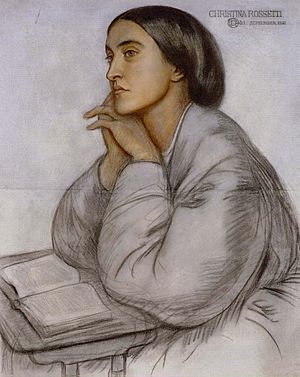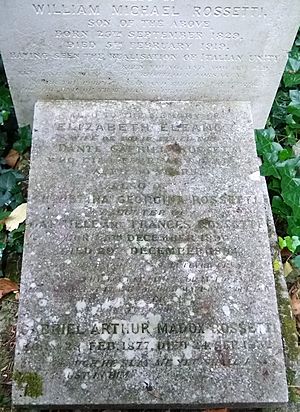Christina Rossetti facts for kids
Quick facts for kids
Christina Rossetti
|
|
|---|---|
 |
|
| Born | Christina Georgina Rossetti 5 December 1830 London, England |
| Died | 29 December 1894 (aged 64) London, England |
| Occupation | Poet |
| Literary movement | Pre-Raphaelite |
| Parents |
|
| Relatives |
|
| Signature | |
Christina Georgina Rossetti (5 December 1830 – 29 December 1894) was an English writer of romantic, devotional and children's poems, including "Goblin Market" and "Remember". She also wrote the words of two Christmas carols well known in Britain: "In the Bleak Midwinter", later set by Gustav Holst, Katherine Kennicott Davis, and Harold Darke, and "Love Came Down at Christmas", also set by Darke and other composers. She was a sister of the artist and poet Dante Gabriel Rossetti and features in several of his paintings.
Early life and education
Christina Rossetti was born in 38 Charlotte Street (now 110 Hallam Street), London, to Gabriele Rossetti, a poet and a political exile from Vasto, Abruzzo, Italy, since 1824 and Frances Polidori, the sister of Lord Byron's friend and physician John William Polidori. She had two brothers and a sister: Dante Gabriel became an influential artist and poet, and William Michael and Maria both became writers. Christina, the youngest and a lively child, dictated her first story to her mother before she had learnt to write.
Rossetti was educated at home by her mother and father through religious works, classics, fairy tales and novels. Rossetti delighted in the works of Keats, Scott, Ann Radcliffe and Matthew Lewis. The influence of the work of Dante Alighieri, Petrarch and other Italian writers filled the home and influenced Rossetti's later writing. Their household was open to visiting Italian scholars, artists and revolutionaries. The family homes in Bloomsbury at no.38 and later no.50 Charlotte (Hallam) Street (now demolished) were within easy reach of Madame Tussauds, London Zoo and the newly opened Regent's Park, which she visited regularly. Unlike her parents, Rossetti felt at home in London and was seemingly happy.

In the 1840s, Rossetti's family faced financial troubles due to a deterioration in her father's physical and mental health. In 1843, he was diagnosed with persistent bronchitis, possibly tuberculosis, and faced losing his sight. He gave up his teaching post at King's College and though he lived another 11 years, suffered from depression and was never physically well again. Rossetti's mother began teaching to support the family, and Maria became a live-in governess, a prospect that Christina Rossetti dreaded. At the time her brother William was working for the Excise Office and Gabriel was at art school, leaving Christina increasingly isolated at home. When she was 14, she suffered a nervous breakdown and left school. Bouts of depression and related illness followed. During this period she, her mother and her sister became absorbed in the Anglo-Catholic movement that developed in the Church of England. Religious devotion came to play a major role in her life.
In her late teens, Rossetti became engaged to the painter James Collinson, the first of three suitors. He, like her brothers Dante and William, was a founding member of the avant-garde Pre-Raphaelite Brotherhood, established in 1848. The engagement ended in 1850 when he reverted to Catholicism. In 1853, when the family had financial difficulties, Christina helped her mother keep a school in Fromefield, Frome, but it did not succeed. A plaque marks the house. In 1854 the pair returned to London, where Christina's father died. She later became involved with the linguist Charles Cayley, but declined to marry him, also for religious reasons. A third offer came from the painter John Brett, whom she likewise refused.
Rossetti sat for several of Dante Gabriel Rossetti's paintings. In 1848, she sat for the Virgin Mary in his first completed oil painting, The Girlhood of Mary Virgin, and the first work he inscribed with the initials "PRB", later revealed as standing for the Pre-Raphaelite Brotherhood. The following year she modelled for his depiction of the Annunciation, Ecce Ancilla Domini. A line from her poem "Who shall deliver me?" inspired a painting by Fernand Khnopff called I lock my door upon myself. In 1849 she again became seriously ill with depression, and around 1857 had a major religious crisis.
Career
From 1842 onward Rossetti began writing down and dating her poems. Most of them imitated her favoured poets. In 1847 she began experimenting with verse forms such as sonnets, hymns and ballads, while drawing narratives from the Bible, folk tales and the lives of saints. Her early pieces often meditate on death and loss in the Romantic tradition. Her first two poems published were "Death's Chill Between" and "Heart's Chill Between", in the Athenaeum magazine in 1848. She used the pseudonym "Ellen Alleyne" in the literary periodical, The Germ, published by the Pre-Raphaelites from January to April 1850 and edited by her brother William. This marked the beginning of her public career.
Rossetti's more critical reflections on the artistic movement her brother had begun were expressed in an 1856 poem "In the Artist's Studio". Here she reflects on seeing multiple paintings of the same model. For Rossetti, the artist's idealised vision of the model's character begins to overwhelm his work, until "every canvas means/the one same meaning." Dinah Roe, in her introduction to the Penguin Classics collection of Pre-Raphaelite poetry, argues that this critique of her brother and similar male artists is less about "the objectification of women" than about "the male artist's self-worship".
Rossetti's first commercially printed collection, Goblin Market and Other Poems, published under her own name by Macmillan & Co. in 1862, when she was 31. It was widely praised by critics, who placed her as the foremost female poet of the day; sales, however, were disappointing. She was lauded by Gerard Manley Hopkins, Algernon Swinburne and Tennyson. After its publication, she was named the natural successor to Elizabeth Barrett Browning, who had died the year before in 1861.
Rossetti worked voluntarily in 1859–1870 at the St Mary Magdalene house of charity in Highgate. Swinburne in 1883 dedicated A Century of Roundels to Rossetti, as she adopted his roundel form in a number of poems, for instance in Wife to Husband. She was ambivalent about women's suffrage, but many have found feminist themes in her work. She opposed slavery in the United States and cruelty to animals in prevalent vivisection.
Rossetti kept a wide circle of friends and correspondents. She continued to write and publish for the rest of her life, mainly devotional work and children's poetry. In the years just before her death, she wrote The Face of the Deep, (1892) a book of devotional prose, and oversaw an enlarged edition of Sing-Song, originally published in 1872, in 1893. She died late the next year.
Rossetti was one of the very first female stamp collectors, beginning her collection in 1847, just seven years after the first stamp was issued.
Later life
In her later decades, Rossetti suffered from a type of hyperthyroidism – Graves' disease – diagnosed in 1872, suffering a near-fatal attack in the early 1870s. In 1893, she developed breast cancer. The tumour was removed, but there was a recurrence in September 1894.
Christina Rossetti died in great pain and anguish of cancer on 29 December 1894 and was buried on 2 January 1895 in the family grave on the west side of Highgate Cemetery, which, notoriously had been opened in October 1869 so that Gabriel could retrieve a volume of poems he had buried with his wife. There she joined her father, mother and Elizabeth Siddal, wife of her brother Dante Gabriel. Her brother William was also buried there in 1919, as were the ashes of four subsequent family members.
There is a stone tablet on the façade of 30 Torrington Square, Bloomsbury, marking her final home, where she died.
Recognition
Rossetti's popularity in her lifetime did not approach that of her contemporary Elizabeth Barrett Browning, but her standing remained strong after her death. Her popularity faded in the early 20th century in the wake of Modernism, but scholars began to explore Freudian themes in her work, reaching for personal, biographical interpretations of her poetry. Academics studying her work in the 1970s saw beyond the lyrical sweetness to her mastery of prosody and versification. Feminists held her as symbol of constrained female genius and a leader among 19th-century poets. Her writings strongly influenced writers such as Ford Madox Ford, Virginia Woolf, Gerard Manley Hopkins, Elizabeth Jennings, and Philip Larkin. The critic Basil de Sélincourt called her "all but our greatest woman poet... incomparably our greatest craftswoman... probably in the first twelve of the masters of English verse."
Rossetti's Christmas poem "In the Bleak Midwinter" became widely known in the English-speaking world after her death, when set as a Christmas carol by Gustav Holst and later by Harold Darke. Her poem "Love Came Down at Christmas" (1885) has also been widely arranged as a carol.
British composers receptive to Rossetti's verse included Alexander Mackenzie (Three Songs, Op. 17, 1878), Frederick Cowen, Samuel Coleridge-Taylor (Six Sorrow Songs, Op. 57, 1904), Hubert Parry, Hope Squire, and Charles Villiers Stanford. In 1918, John Ireland set eight poems from her Sing-Song: A Nursery Rhyme Book to music in his song cycle Mother and Child. The poem "Song" was an inspiration for Bear McCreary's composition When I Am Dead, published in 2015. Two of Rossetti's poems, "Where Sunless Rivers Weep" and "Weeping Willow", were set to music by Barbara Arens in her All Beautiful & Splendid Things: 12 + 1 Piano Songs on Poems by Women (2017, Editions Musica Ferrum). Rossetti's "Love is Like a Rose" was set to music by Constance Cochnower Virtue; "Love Me, I Love You," was set to music by Hanna Vollenhoven; and "Song of the Dawn" was set to music by Elise Fellows White.
In 2000, one of many Millennium projects across the country was a poetry stone placed in what had been the grounds of North Hill House in Frome. On one side is an excerpt from her poem, "What Good Shall My Life Do Me": "Love lights the sun: love through the dark/Lights the moon's evanescent arc:/Same Love lights up the glow-worms spark." She wrote about her brief stay in Frome, which had "an abundance of green slopes and gentle declivities: no boldness or grandeur but plenty of peaceful beauty".
In 2011, Rossetti was a subject of a Radio 4 programme, In Our Time.
The title of J. K. Rowling's novel The Cuckoo's Calling (2013) follows a line in Rossetti's poem A Dirge.
Christina Rossetti is commemorated in the Church of England calendar on 27 April.
See also
 In Spanish: Christina Rossetti para niños
In Spanish: Christina Rossetti para niños


